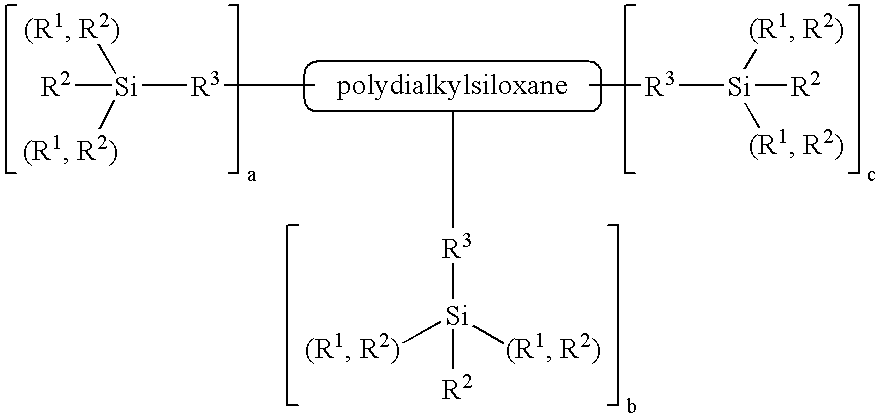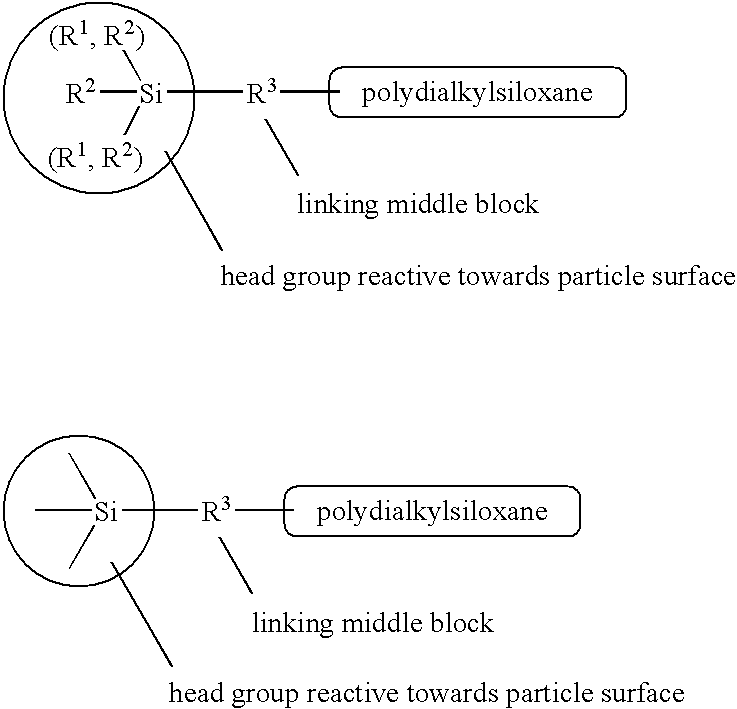Surface-modified nanoparticles, their preparation and use
a technology of surface-modified nanoparticles and nanoparticles, which is applied in the field of surface-modified nanoparticles, their preparation and use, can solve the problems of increasing embrittlement, inability to tolerate embrittlement, and activity subsiding in the course of time, so as to improve mechanical stability, easy to be metered, and scratch resistance
- Summary
- Abstract
- Description
- Claims
- Application Information
AI Technical Summary
Benefits of technology
Problems solved by technology
Method used
Image
Examples
preparation examples
Preparation Example 1
[0073] A 250-ml four-necked flask with heating, internal thermometer, stirrer mechanism, reflux condenser and inert-gas connection is charged with 100 g of Si—H-functional polysiloxane having the following average structure:
[0074] This silicone is easy to prepare by means of an equilibration reaction as described in Noll (Chemie und Technologie der Silicone, Wiley / VCH, Weinheim, 1984). The silicone is heated to 70° C. under nitrogen, and 16.3 g of vinyltrimethoxysilane (e.g.: Geniosil XL10; Wacker Chemie GmbH) are added. Then 10 ppm of hexa-chloroplatinic acid are added. After the exothermic reaction has subsided the reaction mixture is stirred at 80° C. for an hour. Then reduced pressure is applied and approximately 2 g of unreacted vinyltrimethoxsilane and volatile constituents of the polysiloxane are separated off by distillation. The product is of low viscosity and possesses a slightly amberlike colouration.
preparation example 2
[0075] A kitchen mixer (Braun, model MX32) is charged with 100 g of nanoscale alumina (NanoDur, Nanophase Technology Corporation) and 4 g of modifying reagent from Preparation Example 1 are added. The mixture is then homogenized for 1 minute. The powder, coated with modifying reagent, is conditioned at 80° C. for one hour. The modified nanoparticles are in the form of a free-flowing powder with no lumps.
preparation example 3
[0076] 40 g of the modified nanoparticles from Preparation Example 2 are incorporated by stirring into a solution of 56.8 g of methoxypropyl acetate and 3.2 g of wetting and dispersing assistant (BYK 9077, BYK-Chemie GmbH) and the mixture is then dispersed with ultrasound (Dr. Hielscher, UIP 1000, 500 W, 4 min). The resulting dispersion is of low viscosity and shows no tendency whatsoever towards gelling or sedimentation after 28 days' storage.
PUM
| Property | Measurement | Unit |
|---|---|---|
| Fraction | aaaaa | aaaaa |
| Percent by mass | aaaaa | aaaaa |
| Mass | aaaaa | aaaaa |
Abstract
Description
Claims
Application Information
 Login to View More
Login to View More - R&D
- Intellectual Property
- Life Sciences
- Materials
- Tech Scout
- Unparalleled Data Quality
- Higher Quality Content
- 60% Fewer Hallucinations
Browse by: Latest US Patents, China's latest patents, Technical Efficacy Thesaurus, Application Domain, Technology Topic, Popular Technical Reports.
© 2025 PatSnap. All rights reserved.Legal|Privacy policy|Modern Slavery Act Transparency Statement|Sitemap|About US| Contact US: help@patsnap.com



